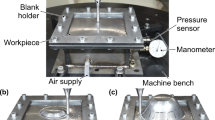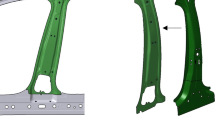Abstract
For successful assembly of flexible parts, informations about their deformation as well as possible misalignments between the holes and their mating parts are essential, since the corrective assembly motion to compensate for such misalignments has to be determined from the measured informations. However, the relationship between them is very complex, and thus cannot be simply derived from analytical methods. This paper presents a neural net-based inference system that can infer the complex relationship between the corrective motion and the measured information of parts deformation and misalignments. The lateral misalignment and the inclination angle of a part are given as the inputs, and the lateral corrective motion is given as the output for the neural network. By using the proposed method, a series of experiments to compensate for the lateral misalignment are performed. Experimental results show that the proposed neural net-based assembly algorithm is effective in compensating for the lateral misalignment from the point of view of a fast search toward the hole center, and that it can be extended to the assembly tasks under more general conditions.
Similar content being viewed by others
References
Hopcroft, J. E., Kearney, J. K. and Krafft, D. B.: A case study of flexible object manipulation, Internat. J. Robotics Res. 10(1) (1991), 41–50.
Smith, P. W., Nandhakumar N. and Ramadorai A. K.: Vision based manipulation of non rigid objects, in: IEEE Int. Conf. on Robotics and Automation, 1996, pp. 3191–3196.
Cho, H. S., Warnecke, H. J. and Gweon, D. G.: Robotic assembly: A synthesizing overview, Robotica 5 (1987), 153–165.
Whitney, D. E.: Quasi-static assembly of compliantly supported rigid parts, ASME J. Dynam. Syst. Measur. Control 104 (1982), 65–77.
Park, Y. K. and Cho, H. S.: Fuzzy rule-based assembly algorithm for precision parts mating, Mechatronics 3 (1993), 433–450.
Kim, W. S., Cho, H. S. and Kim, S.: A new Omnidirectional Image Sensing System for Assembly (OISSA), in: Int. Conf. on IROS, 1996, pp. 611–617.
Merlet, J. P.: A control law for the insertion of a flexible peg by using a robot, in: Proc. of 3rd Int. Conf. of RoViSec., 1983, pp. 453–460.
Zheng, Y. F., Pei, R. and Chen, C.: Strategies for automatic assembly of deformable objects, in: Int. Conf. on Robotics and Automation, 1991, pp. 2598–2603.
Inoue, H. and Inaba, H.: Hand-eye coordination in rope handling, The 1st Int. Sym. on Robotics Research, 1985, pp. 163–174.
Nakagaki, H., Kitagaki, K., Ogasawara, T. and Tsukune, H.: Study of insertion task of a flexible wire into a hole by using visual tracking observed by stereo vision, in: Int. Conf. on Robotics and Automation, 1996, pp. 3209–3213.
Chen, C. and Zheng, Y. F.: Deformation identification and estimation of one-dimensional objects by vision sensors, J. Robotic Systems 9(5) (1992), 595–612.
Kim, J. Y., Cho, H. S. and Kim, S.: A visual sensing system for measuring parts deformation and misalignments in flexible parts assembly, Optics and Lasers in Engineering 15(5) (1998), 379–401.
Zheng, Y. F. and Chen, M. Z.: Trajectory planning for two manipulators to deform Flexible Beams, Robotics and Autonomous System 12 (1994), 55–67.
Al-Jarrah, O., Zheng, Y. F. and Yi, K. Y.: Trajectory planning for two manipulators to deform flexible materials using compliant motion, in: IEEE Int. Conf. on Robotics and Automation, 1995, pp. 1517–1522.
Crandall, S. H., Dahl N. C. and Lardner, T. J.: An Introduction to the Mechanics of Solids, McGraw-Hill, 1978.
Frisch-Fay, R.: Flexible Bar, Washington Butterworths, 1962.
Whitney, D. E.: Force feedback control of manipulator fine motions, ASME J. of Dynam. Syst., Man, and Control (1977), 91–97.
Asada, H.: Teaching and learning of compliance using neural nets: Representation and generation of nonlinear compliance, in: Proc. IEEE Int. Conf. Robotics and Automation, 1990, pp. 1237–1244.
Caine, M. E., Lozano-Perez, T. and Seering, W. P.: Assembly strategies for chamferless parts, in: Proc. IEEE Int. Conf. Robotics and Automation, 1989, pp. 472–477.
Aral, F., Rong, L. and Fukuda, T.: Trajectory control of flexible plate using neural network, in: IEEE Int. Conf. on Robotics and Automation, 1993, pp. 155–160.
Chen, M. Z. and Zheng, Y. F.: Deform flexible beams by two manipulators through neural network learning, in: IEEE Int. Conf. on Robotics and Automation, 1994, pp. 3180–3185.
Zurada, J. M.: Introduction to Artificial Neural Systems, West Publishing Company, 1992.
Kirn, J. Y., Cho, H. S. and Kim, S.: Measurement of parts deformation and misalignments by using a visual sensing system, in: IEEE Int. Sym. on Computational Intelligence in Robotics and Automation, 1997, pp. 362–367.
Author information
Authors and Affiliations
Rights and permissions
About this article
Cite this article
Kim, J.Y., Cho, H.S. A Neural Net-based Assembly Algorithm for Flexible Parts Assembly. Journal of Intelligent and Robotic Systems 29, 133–160 (2000). https://doi.org/10.1023/A:1008115522778
Issue Date:
DOI: https://doi.org/10.1023/A:1008115522778




